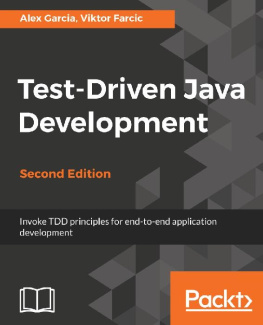Lasse Koskela - Effective Unit Testing: A guide for Java Developers
Here you can read online Lasse Koskela - Effective Unit Testing: A guide for Java Developers full text of the book (entire story) in english for free. Download pdf and epub, get meaning, cover and reviews about this ebook. year: 2013, publisher: Manning Publications, genre: Computer. Description of the work, (preface) as well as reviews are available. Best literature library LitArk.com created for fans of good reading and offers a wide selection of genres:
Romance novel
Science fiction
Adventure
Detective
Science
History
Home and family
Prose
Art
Politics
Computer
Non-fiction
Religion
Business
Children
Humor
Choose a favorite category and find really read worthwhile books. Enjoy immersion in the world of imagination, feel the emotions of the characters or learn something new for yourself, make an fascinating discovery.
- Book:Effective Unit Testing: A guide for Java Developers
- Author:
- Publisher:Manning Publications
- Genre:
- Year:2013
- Rating:5 / 5
- Favourites:Add to favourites
- Your mark:
Effective Unit Testing: A guide for Java Developers: summary, description and annotation
We offer to read an annotation, description, summary or preface (depends on what the author of the book "Effective Unit Testing: A guide for Java Developers" wrote himself). If you haven't found the necessary information about the book — write in the comments, we will try to find it.
Summary
Effective Unit Testing is written to show how to write good teststests that are concise and to the point, expressive, useful, and maintainable. Inspired by Roy Osheroves bestselling The Art of Unit Testing, this book focuses on tools and practices specific to the Java world. It introduces you to emerging techniques like behavior-driven development and specification by example, and shows you how to add robust practices into your toolkit.
About Testing
Test the components before you assemble them into a full application, and youll get better software. For Java developers, theres now a decade of experience with well-crafted tests that anticipate problems, identify known and unknown dependencies in the code, and allow you to test components both in isolation and in the context of a full application.
About this Book
Effective Unit Testing teaches Java developers how to write unit tests that are concise, expressive, useful, and maintainable. Offering crisp explanations and easy-to-absorb examples, it introduces emerging techniques like behavior-driven development and specification by example.
Programmers who are already unit testing will learn the current state of the art. Those who are new to the game will learn practices that will serve them well for the rest of their career.
Purchase of the print book comes with an offer of a free PDF, ePub, and Kindle eBook from Manning. Also available is all code from the book.
About the Author
Lasse Koskela is a coach, trainer, consultant, and programmer. He hacks on open source projects, helps companies improve their productivity, and speaks frequently at conferences around the world. Lasse is the author of Test Driven, also published by Manning.
Whats Inside- A thorough introduction to unit testing
- Choosing best-of-breed tools
- Writing tests using dynamic languages
- Efficient test automation
- PART 1 FOUNDATIONS
- The promise of good tests
- In search of good
- Test doubles PART 2 CATALOG
- Readability
- Maintainability
- Trustworthiness PART 3 DIVERSIONS
- Testable design
- Writing tests in other JVM languages
- Speeding up test execution
Lasse Koskela: author's other books
Who wrote Effective Unit Testing: A guide for Java Developers? Find out the surname, the name of the author of the book and a list of all author's works by series.













